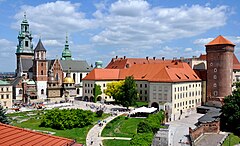Wawel Castle
| Wawel Royal Castle | |
|---|---|
| Zamek Królewski na Wawelu | |

Wawel Castle with the Wawel Cathedral seen on the left.
|
|
|
Location within Poland
|
|
| Alternative names | Wawel |
| General information | |
| Type | Castle residency |
| Architectural style | Romanesque, Gothic, Renaissance |
| Location | Kraków |
| Country | Poland |
| Coordinates | 50°03′14″N 19°56′05″E / 50.05389°N 19.93472°E |
| Client | Casimir III the Great |
| Owner |
Casimir III the Great Louis I of Hungary Queen Jadwiga Jogaila Władysław III Casimir IV Jagiellon John I Albert Alexander I Jagiellon Sigismund I the Old Sigismund II Augustus Henry III Queen Anna Stefan Batory Sigismund III Vasa Władysław IV Vasa John II Casimir Vasa Michael Korybut Wiśniowiecki John III Sobieski Augustus II the Strong Stanisław I Leszczyński Augustus III Stanisław II August Poniatowski (last owner) |
| Website | |
| Official Website | |
The Wawel Castle is a castle residency built at the behest of King Casimir III the Great, who reigned from 1333 to 1370, and consists of a number of structures situated around the central courtyard.
In the 14th century it was rebuilt by Jogaila and Jadwiga of Poland. Their reign saw the addition of the tower called the Hen's Foot (Kurza Stopka) and the Danish Tower. The Jadwiga and Jogaila Chamber, in which the sword Szczerbiec, was used in coronation ceremonies, is exhibited today and is another remnant of this period. Other structures were developed on the hill during that time as well, in order to serve as quarters for the numerous clergy, royal clerks and craftsmen. Defensive walls and towers such as Jordanka, Lubranka, Sandomierska, Tęczyńska, Szlachecka, Złodziejska and Panieńska were erected in the same period.
The Wawel Royal Castle and the Wawel Hill constitute the most historically and culturally important site in Poland. For centuries the residence of the kings of Poland and the symbol of Polish statehood, the Castle is now one of the country’s premier art museums. Established in 1930, the museum encompasses ten curatorial departments responsible for collections of paintings, including an important collection of Italian Renaissance paintings, prints, sculpture, textiles, among them the Sigismund II Augustus tapestry collection, goldsmith’s work, arms and armor, ceramics, Meissen porcelain, and period furniture. The museum’s holdings in oriental art include the largest collection of Ottoman tents in Europe. With seven specialized conservation studios, the museum is also an important center for the conservation of works of art.
People have lived on Wawel Hill at the site of the Castle as early as fifty thousand years ago, in the Paleolithic Age. The settlement was apparently bustling with trade, assorted crafts and local farming. When more people began to settle down on the Wawel Hill and when trade became more efficient, the rulers of Poland took up their residence at the Hill as well.
During the early 16th century King Sigismund I the Old (Zygmunt I in Polish) and his wife brought in the best native and foreign artists including Italian architects, sculptors, and German decorators, to refurbish the castle into a splendid Renaissance palace. It soon became a paragon of stately residence in Central and Eastern Europe and served widely as a model throughout the region.
...
Wikipedia

